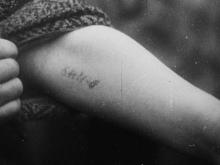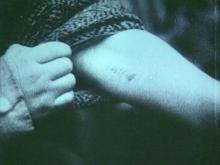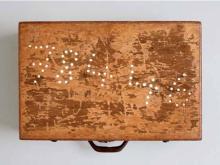Der Rat der Götter
DER RAT DER GÖTTER, Kurt Maetzig, GDR 1950
The use of the shots from Auschwitz in Kurt Maetzig’s film DER RAT DER GÖTTER (1950), produced for the East-German DEFA, represents one of the first cases of meta-mediation. Liberation footage, including the children in Auschwitz, is projected on a diegetic screen and thereby categorized as cinematic evidence. This happens with the help of a condensed montage of liberation footage. Images of prisoners behind barbed wire (from Auschwitz) are superimposed with a close-up of an indictment (as part of a trial against managers of German companies that benefited from and supported Nazi crimes). What follows is a sequence of shots from different liberated camps that are framed by curtains and the ratio of a projection screen. Used in a generally illustrating way, the footage assembles what we still today consider iconic images from the camps, among them the first two shots from the sequence with the children in Auschwitz.
The montage has a clear narrative structure. First, it introduces the prisoners and emphasizes with the shots of the children that they were innocent victims, then demonstrates the industrialized ways of mass killing by utilizing shots of Zyklon B cans, and finally refers to the murderous results by showing corpses in mass graves. Only then do the viewers understand the setting of the screening: a court room that had been transformed into a screening room.
However, most notably in the use of the footage in DER RAT DER GÖTTER is the fact that the film abstains from adding any voice-over or other additional sounds to the montage of images. Only muffled noises of the audience in the court can be heard on the sound track, while the images should speak for themselves. This furthermore emphasises their function as evidence in a double sense: evidence within the diegetic trial setting and evidence for the audience.





